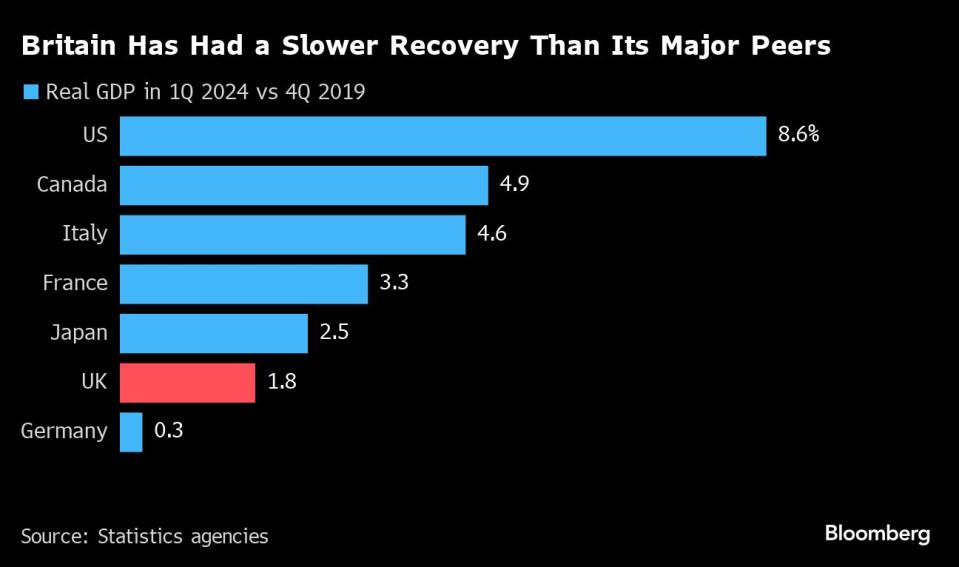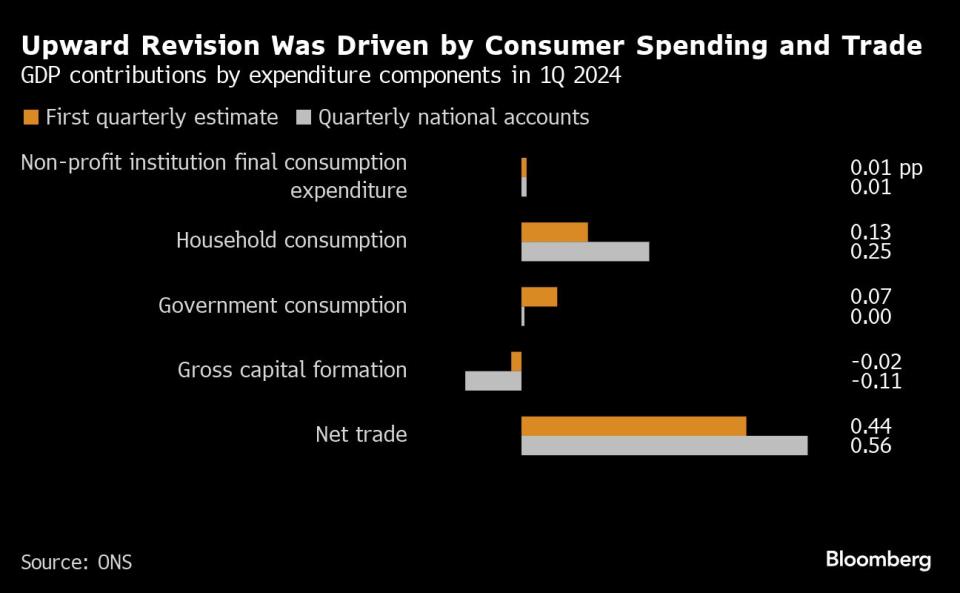UK Grew More Than Expected on Consumer Spending and Services
(Bloomberg) -- Britain’s economy bounced out of recession more quickly than previously estimated with the strongest growth in more than two years, with services and consumer spending both driving the gains.
Most Read from Bloomberg
Panicked Emails, Gallows Humor: The Aftermath of Biden's Debate Disaster
Supreme Court Overturns Chevron Rule in Blow to Agency Power
Gross domestic product expanded 0.7% in the first quarter, the Office for National Statistics said Friday, upgrading its previous estimate for growth of 0.6%. Most economists had expected no revision.
The figures are a boost for Prime Minister Rishi Sunak’s argument that the nation has turned the corner after a mild slump last year. But the benefits of an economy gaining momentum are likely to fall to Keir Starmer’s Labour Party, which has a commanding lead over the Conservatives less than a week before the general election. The Bank of England expects steady growth the rest of the year as consumers benefit from rising wages and a loosening of the cost-of-living squeeze.
Services output jumped by 0.8%, revised up from 0.7%, capping three consecutive quarters of decline. That rebound was driven by professional services and scientific research and development. The ONS also reported stronger trade and consumer spending.
On a per person basis, the economy recovered sharply as well. GDP per head was up 0.5%, revised up from 0.4%, following seven consecutive quarters without growth. GDP per head is still 0.6% below where it was a year ago, the ONS said.
UK living standards climbed for a second straight quarter to their highest level since the final half of 2021, driven by rising pay and falling tax, the ONS report showed. Adjusted for inflation, household disposable income per person rose 0.5%, up from an 0.4% gain in the fourth quarter.
The figures are almost certain to be seized on by Sunak’s Conservatives, who are battling to avert catastrophic losses to the Labour opposition in the July 4 general election.
The figures are “good news for whoever is prime minister this time next week,” said Paul Dales, chief UK economist at Capital Economics. The economy may be “a bit stronger than already above-consensus forecast.”
Stronger growth may also make the BOE more concerned about lingering inflationary pressure, potentially holding off its first reductions in interest rates since the pandemic. Markets shrugged off the report, with little change in the pound or bets on interest rate reductions later this year. Investors are pricing in the strong chance of a move in September.
“At the margins, all this may make the Bank of England a bit less comfortable cutting interest rates in August,” Dales said.
Britain’s recovery from the pandemic is still trailing all except for Germany in the Group of Seven nations, with growth of 1.8% since the end of 2019 before the virus struck. The US by contrast has boomed by 8.6%.
UK wages are once again growing faster than prices, helping to repair household finances that were battered by 2022’s energy-price shock and double-digit inflation. A further fillip is expected in the current quarter after April’s cut in payroll taxes and big increases in welfare payments, the state pension and the minimum wage.
However, it may still leave real incomes no higher than they were before the last election in 2019, and possibly lower.
There are still signs that consumers remain cautious. The savings ratio, which shows the amount of disposable income that people choose not to spend, rose to 11.1% in the first quarter, the highest since the second quarter of 2021. That’s a sharp contrast with the US position, where consumers have lifted spending by holding back a relatively small portion of their incomes.
The Bank of England expects the UK economy to grow 0.5% in the second quarter, faster than previously projected.
Separate figures showed the current-account deficit, the difference between money leaving the UK and money coming in, narrowed to £21 billion ($26.5 billion), or 3.1% GDP, in the first quarter. Excluding precious metals, flows of which can be volatile, the deficit fell by £2.5 billion to £23.8 billion.
The improvement was driven by a lower trade deficit, which was partially offset by a higher deficit on flows of investment income.
--With assistance from Harumi Ichikura.
(Updates with current account and charts)
Most Read from Bloomberg Businessweek
Japan’s Tiny Kei-Trucks Have a Cult Following in the US, and Some States Are Pushing Back
The FBI’s Star Cooperator May Have Been Running New Scams All Along
RTO Mandates Are Killing the Euphoric Work-Life Balance Some Moms Found
How Glossier Turned a Viral Moment for ‘You’ Perfume Into a Lasting Business
©2024 Bloomberg L.P.

 Yahoo News
Yahoo News 






